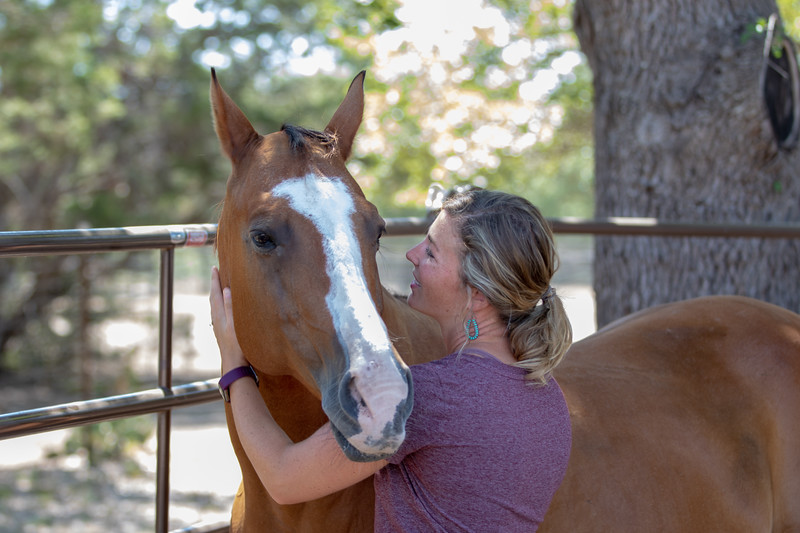
by Jamie Morley | Apr 20, 2019 | Applied Principles, Case Studies, Testimonials & Reflections
In December 2017, I attended my first NL Intensive training in Brenham, TX. I’m pretty sure it was day two, which in my experience at these trainings, is when things really start getting stirred up internally. This life lesson came to me in my blind spot. Like a horse’s blind spot, it was right in front of my face (or maybe right behind my rear?). In fact, the only one who could see what was going on was my partner for the weekend.
I was in the round pen with the horse, Indigo (name has been changed for this article), trying to connect through attachment. When we had worked together the day before, we had a pretty quick connection, so I figured it would happen pretty easily again. This was not the case. Indigo was completely ignoring me. So I started to gradually increase my efforts, going from clucking and calling her name, to stomping my feet, to waving my hands in the air, to getting closer and jumping up and down and waving my hands all at the same time.
My partner stopped me (thank goodness!). I walked over to her and took a much needed break from all the jumping and flailing around. She said something simple like, “It seems to me like your energy on the outside does not match your energy on the inside”. At first I shot a quick answer back like, “Really? I feel like all of my energy is as high as it can go! I don’t know what else to do.” And then the thought settled somewhere deep within, and I took a deep breath and looked at her. She was right.
At some point, Tim Jobe had joined the conversation (he has a way of popping in at the just the right moment). He asked something to the effect of, “What might be keeping you from raising your internal energy?” I explained that it felt like there is a line that divides where I feel safe and comfortable to make an “ask” in a relationship and where it feels all together too risky and vulnerable. Tim asked, “What is the risk if you cross that line?” I started to process out loud about how if I gave more energy toward the relationship, what if it wasn’t reciprocated? What if she still kept ignoring me? The fear of losing what connection I did have seemed to outweigh the potential of gaining an even deeper connection. A wave of realization was rushing over me. This, of course, directly correlated to how I often felt in my human relationships.
Then something beautiful happened that I’ll never forget. By this point, I was back to standing in proximity to Indigo. As soon as I acknowledged my true inner feelings to Tim and my partner, Indigo turned and came toward me. She planted herself right there next to me as tears began to steadily stream down my face. I hadn’t even asked her to come over. She chose to all on her own. And all I could do was stand there next to her and let the tears fall freely. I savored that moment with her and all that she “said” to me through her actions.
In a way that only a horse can, she affirmed so many truths for me in this moment. She affirmed that all she wanted was the real me. She didn’t require that I had it all together. She only required that I was being real with myself and with her. It was as if she was saying, “Oh good, you’re truly present with me and now I want to come be with you”. She also affirmed that the experience of a connection like this was totally worth the risk and vulnerability it took to get it.
“Most people believe vulnerability is weakness. But really, vulnerability is courage. We must ask ourselves…are we willing to show up and be seen?”
–Brene Brown
Self-sufficiency has met her match, her name is Vulnerability. It’s only through vulnerability that true connection is experienced. Self-sufficiency may give a false sense of security, but it will forever leave me feeling disconnected from others. Indigo helped me realize that what I want more than independence and self-sufficiency is the sense of being known and accepted for who I am. In order to get this, I have to show up in relationships as my authentic, vulnerable, messy self.
Every day we have the choice. Today I choose vulnerability.
—————————————————————————
Jamie offers life coaching, both equine assisted and non-equine, to the Central Ohio area. She is dual certified through Natural Lifemanship as a Practitioner and an Equine Professional and is a certified Life Coach through the JRNI Catalyst Coaching Intensive. Her coaching business, Hope Anew, thrives on this motto: Healing Occurs through Purposeful Elements- Art, Nature, Environment, and Well-being. She loves taking creative approaches to helping people on their path to personal growth, as the path to transformation looks different for everyone!
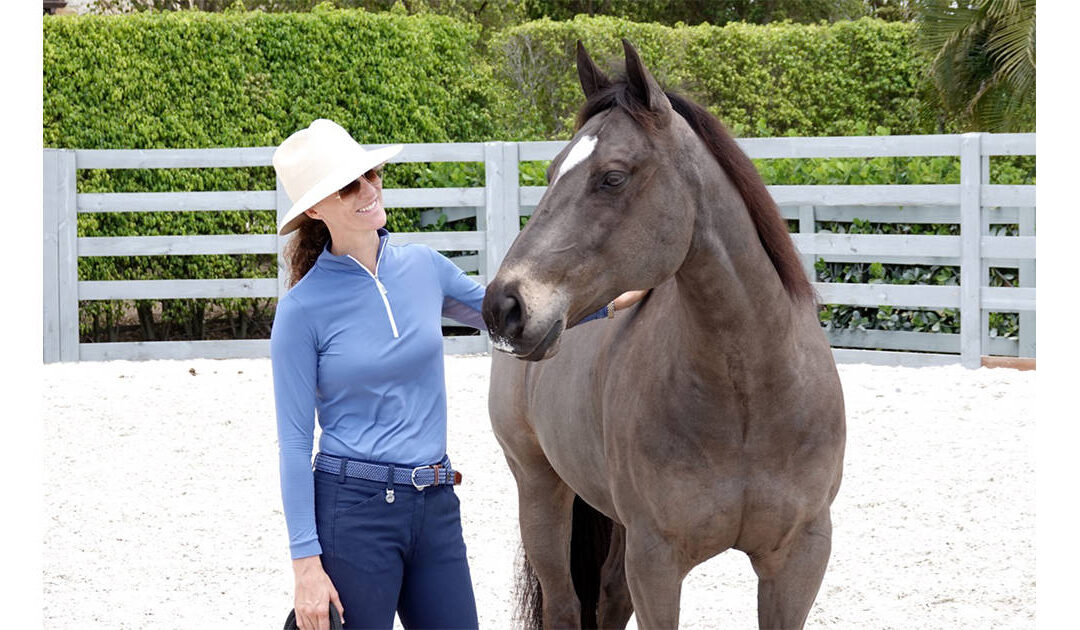
by Sarah Willeman | Aug 20, 2018 | Basics of Natural Lifemanship, Equine Assisted Trainings, Testimonials & Reflections
By Sarah Willeman
Building Connected Relationships
Horse-assisted psychotherapies show tremendous promise in helping people with trauma, which is notoriously difficult to treat. Trauma lives not only in our conscious mind but deeper in our nervous system, in parts of the brain responsible for basic survival. We can’t will our way—or talk our way—out of it. Horses can help people regulate those deeper brain regions. Recently I attended a training in one particular therapy model that’s captured my attention. It’s based on healing through connected relationships, beginning with the horse.
The Model
The model is called Natural Lifemanship. I found the name corny at first, but now I get it. Beyond just therapy, this is a way of being in the world—a guiding mindset for building relationships in all areas, with people and animals. The Natural Lifemanship school of therapy is called Trauma-Focused Equine-Assisted Psychotherapy (TF-EAP). It’s based on the structure and function of the brain, and it combines neurobiology with sound relationship principles. People learn these principles in the context of their relationship with the horse and can then transfer them to other relationships in their lives.
The founders, Bettina Shultz-Jobe and Tim Jobe, have backgrounds in psychotherapy with at-risk groups and horsemanship with challenging cases, like wild mustangs. (In his job starting mustangs, Tim could take a horse never before touched by a person and be riding him in a couple of hours—and not through coercive techniques.) In other words, the founders have deep expertise with both horses and psychology. And the method goes far beyond just that “magical” quality that contact with horses can have. This work has clear principles, organization, and purpose and has helped a lot of people.
The Neurobiology
A horse’s brain works in similar ways to that of a traumatized person: the lower, survival-focused brain regions are largely running the show.
The Equine Brain
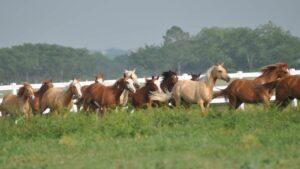
Horses’ brains are naturally built this way. Compared to humans, horses have a small neocortex, the region responsible for thinking. In herd life, only the lead mare needs to do much thinking. Horses mainly need their fight-or-flight reflexes, and they need to follow the herd. Survival is the horse’s essential skill, and it’s governed by the lower brain.
The Human Brain in Trauma
With trauma, a person becomes stuck in those same lower brain regions. The fight-or-flight response actually has a third component: it’s fight, flight, or freeze. When a person is stuck in these states, the survival regions of the brain get over-exercised, the nervous system becomes dysregulated, and the person has trouble regaining internal calm—the calm that’s necessary for good relationships and physical wellbeing.
That over-exercising of the lower brain leads to two things, anatomically: it builds up the lower brain and simultaneously sacrifices connections to the upper brain regions, where thinking and emotional connection happen. There’s a use-it-or-lose-it phenomenon with brain pathways. A traumatized person has trouble with self-regulation because many of the cross-brain connections that allow us to consciously calm our survival reflexes have been lost—or in the case of childhood trauma, perhaps never created.
Healing the Brain

The good news is the brain has plasticity, and new connections can be formed. The most effective trauma therapy will first regulate the lower brain and then engage the upper brain regions, thereby forming new pathways, helping all parts of the brain to integrate with each other for healthy functioning.
In Natural Lifemanship, it’s crucial to understand which part of the brain a horse or person is responding or reacting from. (Responding is associated with calm, integrated thinking; reacting is habitual and reflexive.) This understanding is important because if someone’s in survival mode and you try to reason with their thinking brain, they’re simply not there to receive what you have to say.
Horses demonstrate this phenomenon. A scared horse cannot learn. The best horsemen understand that training through intimidation will ultimately fail. The horse might robotically comply out of fear, but he’ll eventually make a panicked mistake, or try to run away from the rider’s signals, or become injured from the constant stress. But a horse in a calm, connected state can develop and flourish.
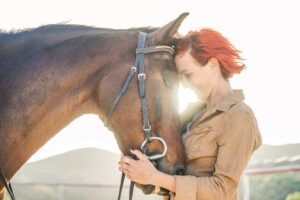
And here’s what gives rise to a powerful road to healing: humans and horses are born with an innate desire to connect.
We want to form safe, caring bonds with other beings; we yearn for experiences of trust and mutual understanding. In fact, as psychology’s well-established field of Attachment Theory teaches, we need those safe connections in order to have a healthy nervous system. Natural Lifemanship uses the power of emotional connection to heal and integrate the brain of both human and horse.
How Natural Lifemanship Works
Although the principles can be applied in any setting, the primary mode of TF-EAP is working with horses in the round pen.
The person gradually builds a healthy, connected relationship with the horse by learning to make requests of the horse, recognize the horse’s signals, and respond appropriately.
This process requires the person to become aware of her internal state, which the horse instinctually senses. (You could do the same outward gestures with different internal states and get a completely different reaction from the horse.) Throughout the work, the therapist and horse together help the person develop self-awareness and self-regulation, as new neural pathways are formed.
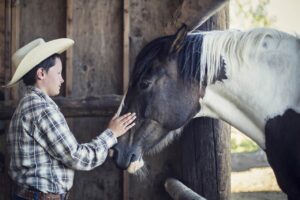
If the person’s nervous system is too agitated, the therapist can use specific techniques to calm those lower brain regions. Certain types of sensory input and movement—namely, rhythmic and repetitive—have been found to regulate and soothe the nervous system. (Think of a steady heartbeat or rocking a baby.) TF-EAP therapists use a variety of proven methods to help the client regulate her brain from the bottom up; in other words, beginning with the lowest brain region that needs support. The survival-focused brainstem has to settle before higher brain regions like the limbic system and neocortex can be engaged in relationship-building activities.
The Horse-Human Relationship
A connected relationship is one in which both parties choose to do what’s right for the relationship, and those choices are made freely and willingly.
In Natural Lifemanship, the relationship with the horse is not a metaphor or proxy for a human relationship; rather, it’s a real relationship. Although there’s apparent overlap with many schools of Natural Horsemanship, there are important differences, too. Instead of viewing the human as the horse’s leader and asking the horse to be submissive, Natural Lifemanship seeks a dynamic of mutual respect and trust, with self-regulation and good decision-making on both sides. The horse learns to pause, think and freely choose to do the right thing.
This key conceptual difference arises from the model’s basis in neurobiology. Just as a human can develop new neural pathways, a horse can, too. Interactions with humans offer a unique opportunity to actually build up the horse’s neocortex (and capacity for self-regulation) in a way that wouldn’t happen in herd life.
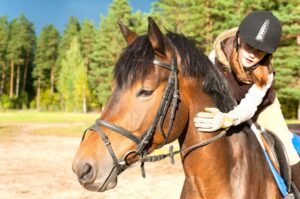
And because horses are so direct—their responses are immediate and honest—they provide excellent feedback for the person. Horses sense how we really feel. Communication is visceral and genuine. When it goes well, there is a simple, genuine pleasure. Connection is inherently rewarding for both human and horse.
As human and horse begin to co-regulate, they help each others’ nervous systems become calm, integrated and functional. And that quality of mutual benefit is essential for true connection and healing. Natural Lifemanship teaches a profoundly empowering skill: how to develop a strong relationship that’s good for both parties.
These are two key principles:
- “If it’s not good for both, it’s eventually not good for either.”
- “Regardless of the task or activity, connection is always the goal.”
These principles can be applied to work with horses and to all relationships with people and animals.
Compliance Versus Cooperation
In order to create connection, we need to understand the difference between compliance and cooperation. Compliance is a submissive action; it’s reflexive and robotic, arising from the lower brain’s survival instinct. On the other hand, cooperation is willing and freely chosen, arising from an integrated, whole-brain process in which the horse calmly figures out what to do.
So how do we tell the difference?
Well, it can be hard, because both can lead temporarily to very similar outward behaviors. Certainly, there are emotional cues, which can be subtle. But the real answer lies in the process.
Asking For Connection
As Natural Lifemanship explains, “Connection is predicated on a request.” In other words, rather than waiting for connection to magically happen, we need to ask for it. And how we ask—or how strongly we ask—has a major impact on the horse’s (or person’s) response.
The teaching is this: neither placate nor coerce. Both those extremes will eventually lead to aggressive behavior from the horse. (And as we talk about the horse here, continue to think of parallels with people.) Between those extremes lies the powerful zone of growth and connection.
An essential part of the process in TF-EAP is learning to make requests in an authoritative, calm manner, using the appropriate amount of pressure.
The Pressure Continuum
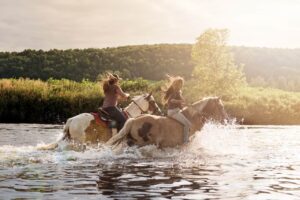
In this context, pressure is not a bad thing but just a fact of the universe. Making a request is a form of pressure. The goal is to use the least amount of pressure necessary.
Too little pressure and we’ll get ignored. Too much pressure and we’ll get fight-or-flight-type reactivity. Imagine an example: if someone yells at you when you’d’ve been happy to listen to a kind request, you might be mad (fight) or scared (flight) or too startled to know what to do (freeze).
Similarly, too much pressure can scare or anger a horse. If he’s in this state and still complies with our immediate request, he’s in his survival brain. This is not freely-chosen cooperation, and it’s not connection.
The appropriate amount of pressure compels the horse to search for an answer but leaves his options open, so he can figure it out and make a voluntary choice. This is the sweet spot of learning and relationship-building.
When we make a request of the horse, he can do one of three things: ignore, resist or cooperate. Herein lies one of the most powerful insights of the work: resistance is not necessarily bad. It means he’s trying to find an answer.
If he tries some wrong answers, we just keep the pressure the same. In order to do so, we need to stay calm and maintain control of our body energy, which can be hard to do when we’re not getting what we want. (Master horsewoman Sarah Dawson described this phenomenon during foal training: “I have to be careful I don’t take offense to any of the wrong answers he tries. He’s just trying to figure it out.”) We need self-awareness and self-regulation in order to succeed at this step.
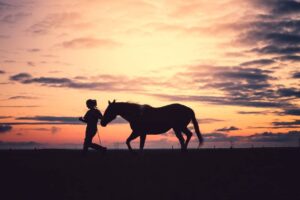
Then—and this is equally crucial—when the horse begins to find the right answer, we immediately release the pressure. Which probably sounds familiar; the timing of pressure and release is the most fundamental skill of horse training. But you’d be surprised how often people mess this up, with horses and with other humans.
In the Round Pen
So, what does all this look like in the round pen?
With the horse lose in the pen, we apply pressure by raising the energy of our body and directing that energy—movement, sound, internal state—toward the horse.
We might lift our arm or swing a rope; cluck or make other sounds; walk more energetically or, at the extreme end, stomp our feet. Depending on the sensitivity of the horse, we could get a response from just a small shift in our energy. The specific direction of our energy is crucial, beginning with the direction of our gaze.
And an important note: we need to learn to raise our energy while maintaining a state of calm. Energy and agitation are not the same thing.
In the following series of photos, I’m working with Cruz on attachment, which is a central part of the method. In this case, attachment means I’m asking him to follow me. Here’s what to look for:
The Request
To ask Cruz for attachment, I apply pressure to his hindquarters. (Another difference from typical horse training, which drives the horse forward from the hindquarters. Here, to ask him to move forward I’d apply pressure near the girth region, where my leg would be if I were riding.) To begin with the least amount of pressure, I simply look at his hindquarters, with my torso pointing toward that part of his body. If necessary, I can increase my body energy and movement from there.
The Release
I want him to turn his attention toward me and begin to move in my direction, so those are the things I reward by releasing pressure—specifically, by lowering my body energy/movement/gestures, backing away, softening my voice, or actually turning and walking away. I don’t reward submissive gestures like dropping his head and licking his lips. If he does those things after I’ve released the pressure, that’s all right; it’s a sign of relaxation (along with yawning, sighing or snorting in that particular relaxed horsey way). But if he does those things in response to pressure, it’s a reflexive, lower-brain attempt at submission, which we don’t want.
The Connection
When he attaches and follows me, I let myself really feel the enjoyment of it—which he senses and enjoys as well.
So let’s begin…
Cruz ignores the subtler signals, so I kiss to him and swing the rope to help me raise my body energy: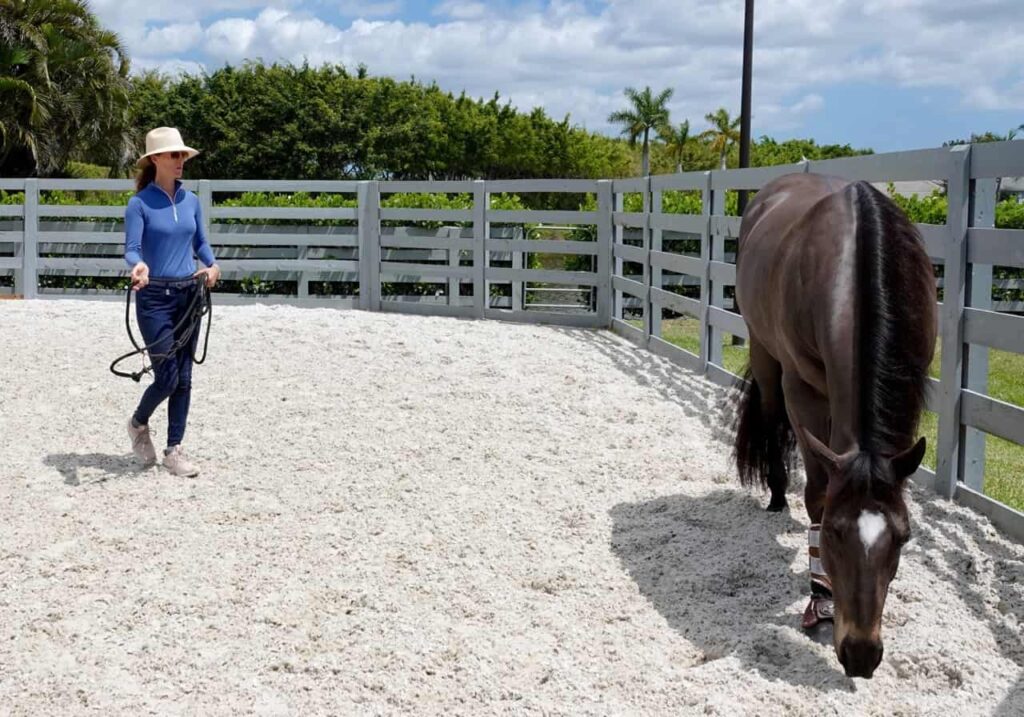
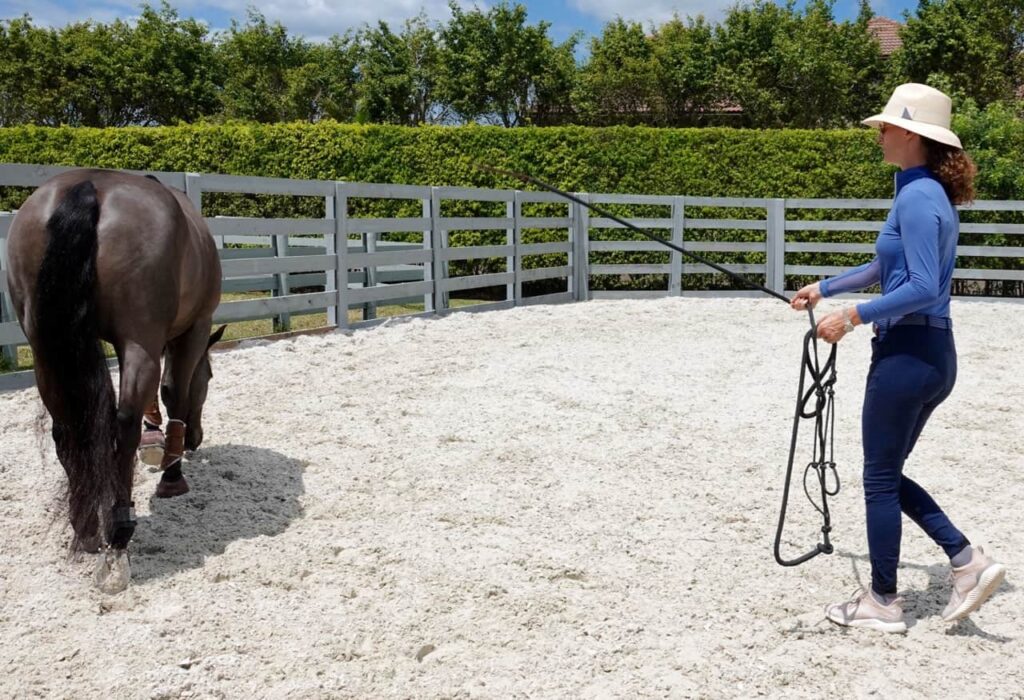
He searches for an answer by trotting away, but since that’s not what I’m asking, I keep the pressure the same:
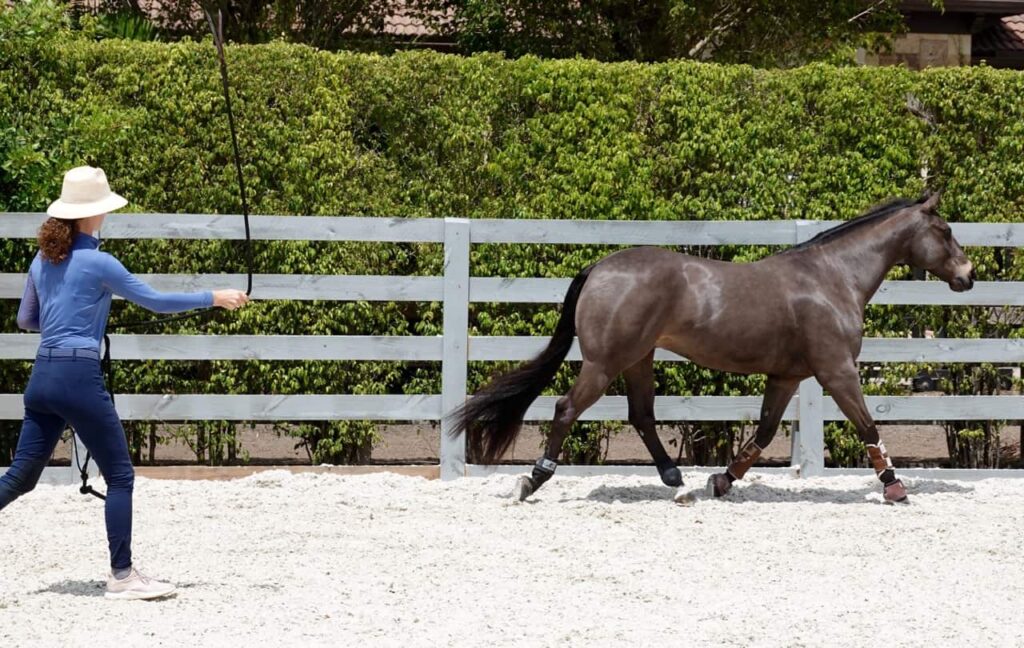
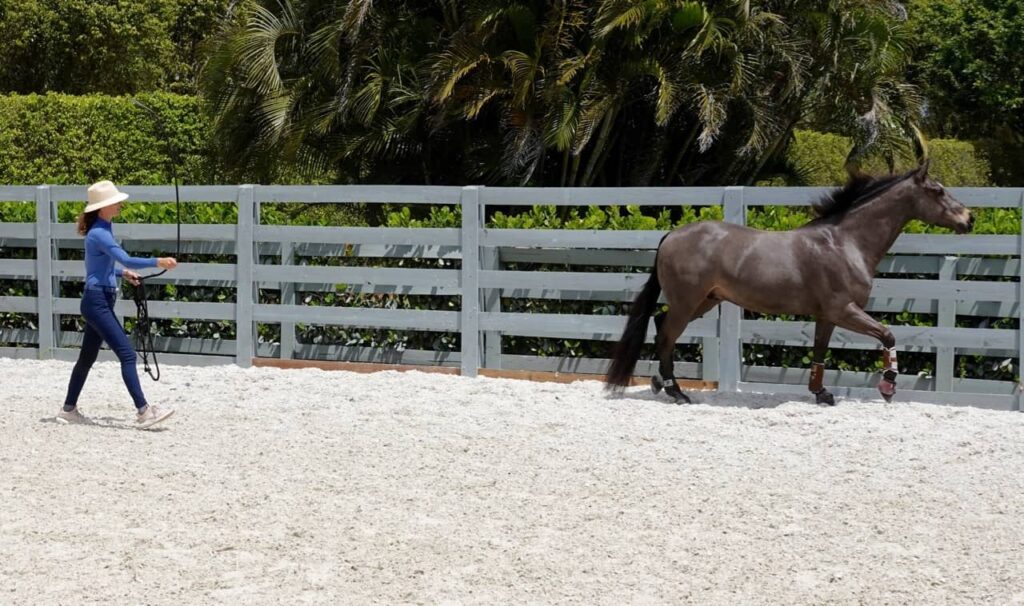
As soon as he starts to slow down and shift his attention toward me, I lower the rope and back away. He walks toward me; I release further by turning and walking away, allowing this sense of connection to soothe my own nervous system:
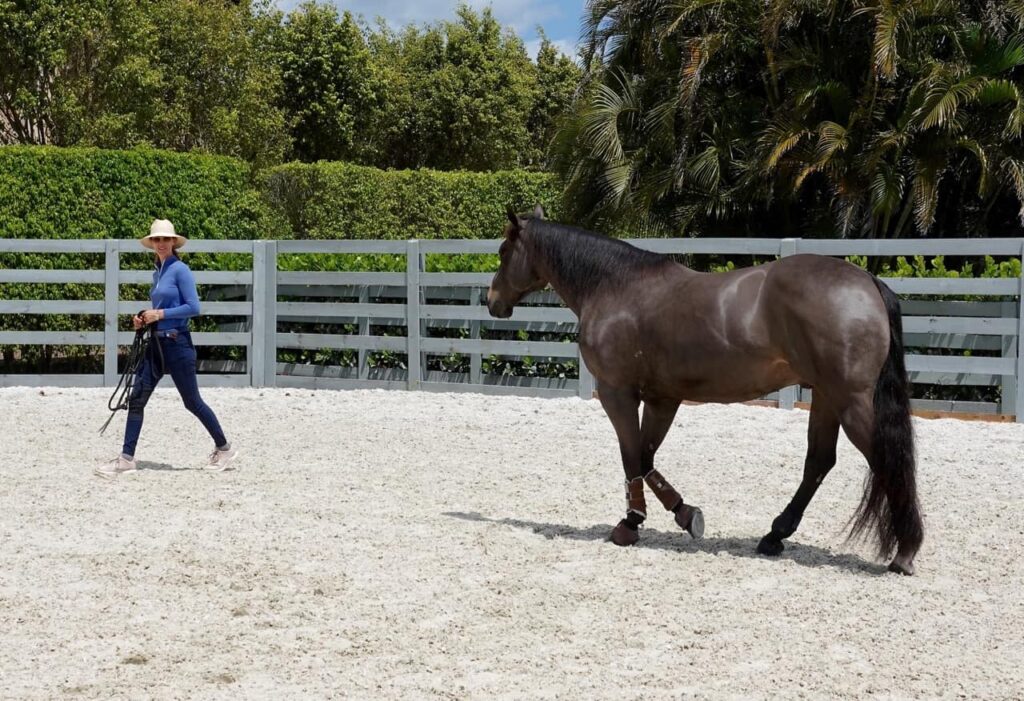
When he reaches me, I stand with him calmly, letting my body energy completely relax. I scratch his withers, praise him, and enjoy hanging out with him:
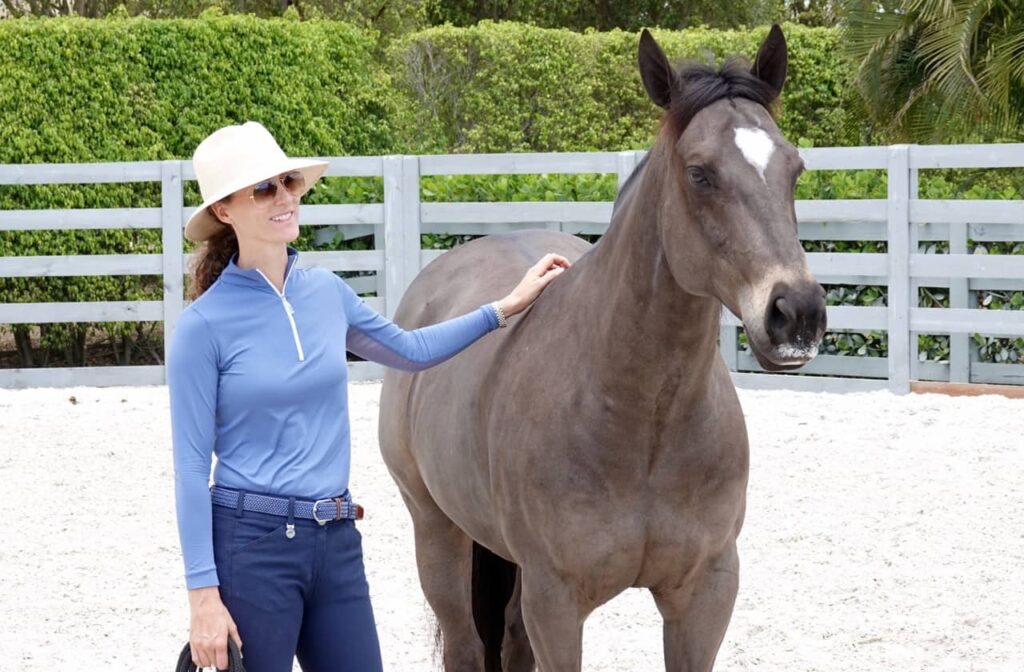
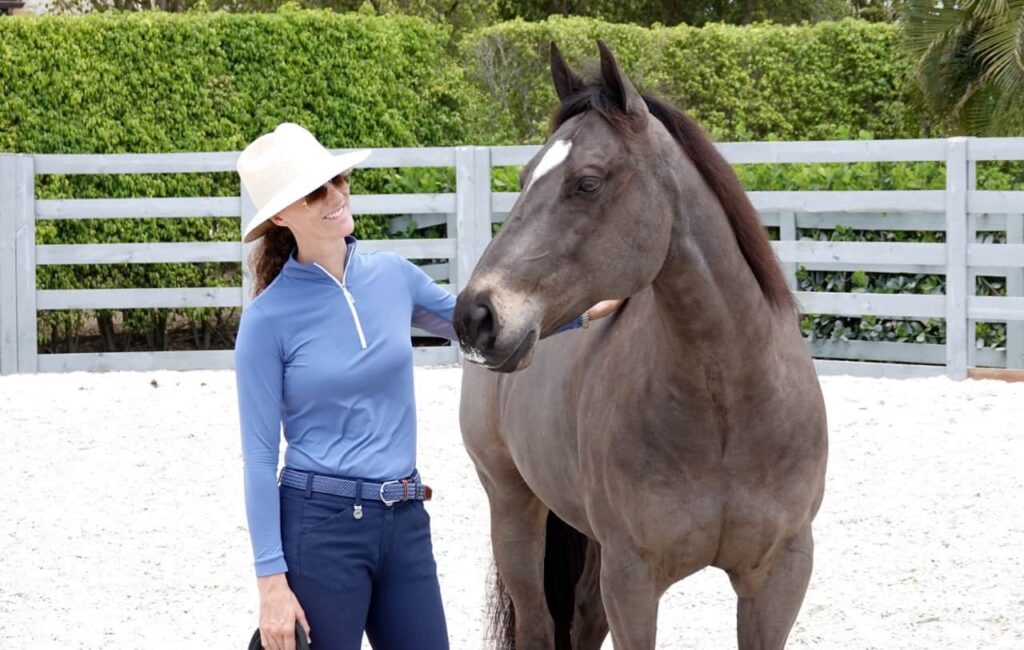
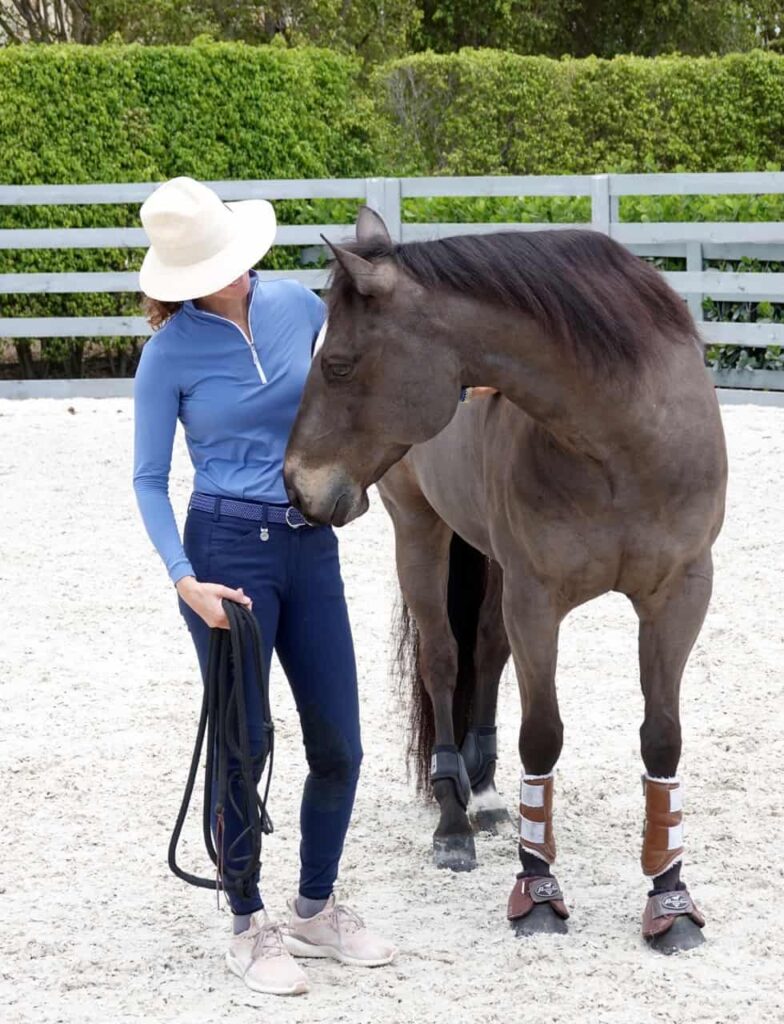
Then I ask him to follow me again, simply by looking toward his hindquarters and kissing to him. This time, he responds to those cues—much less pressure than before—and attaches:
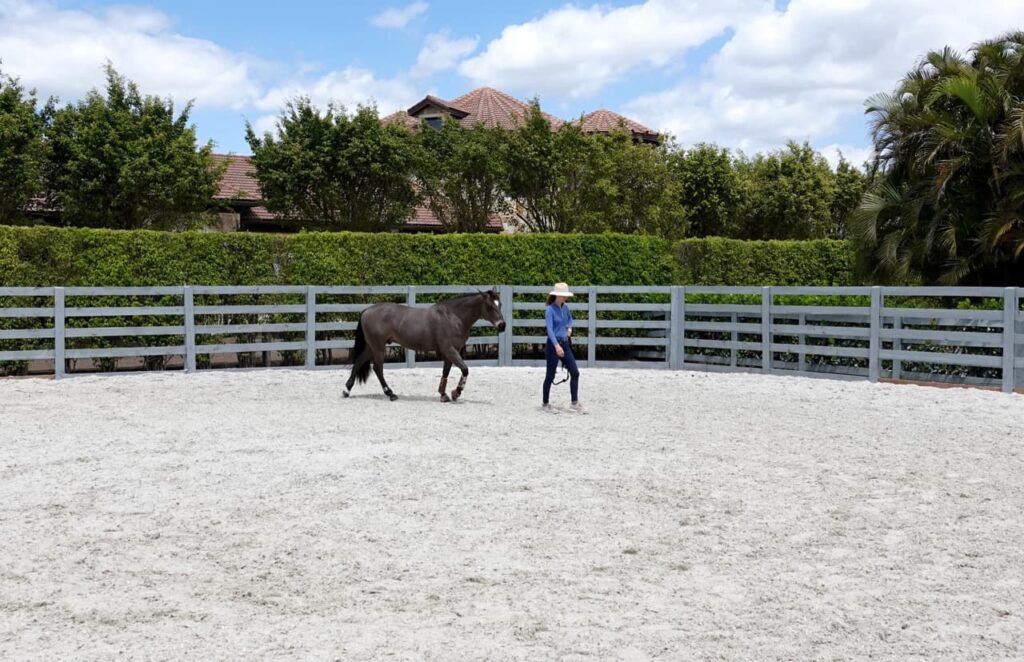

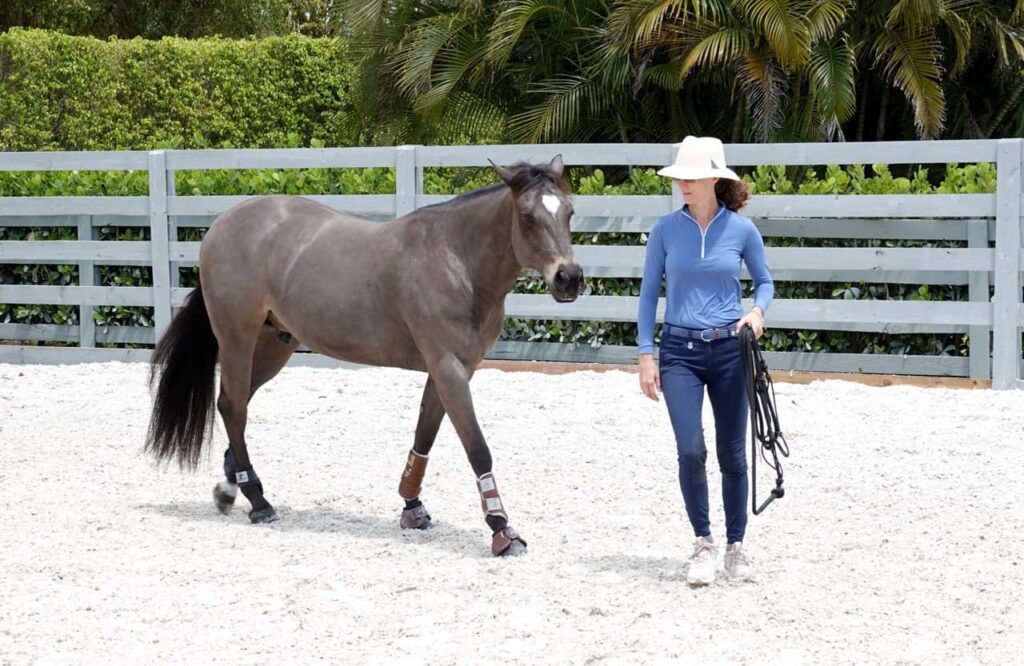
When his attention wanders, I simply notice and make the request again, using the least amount of pressure necessary:
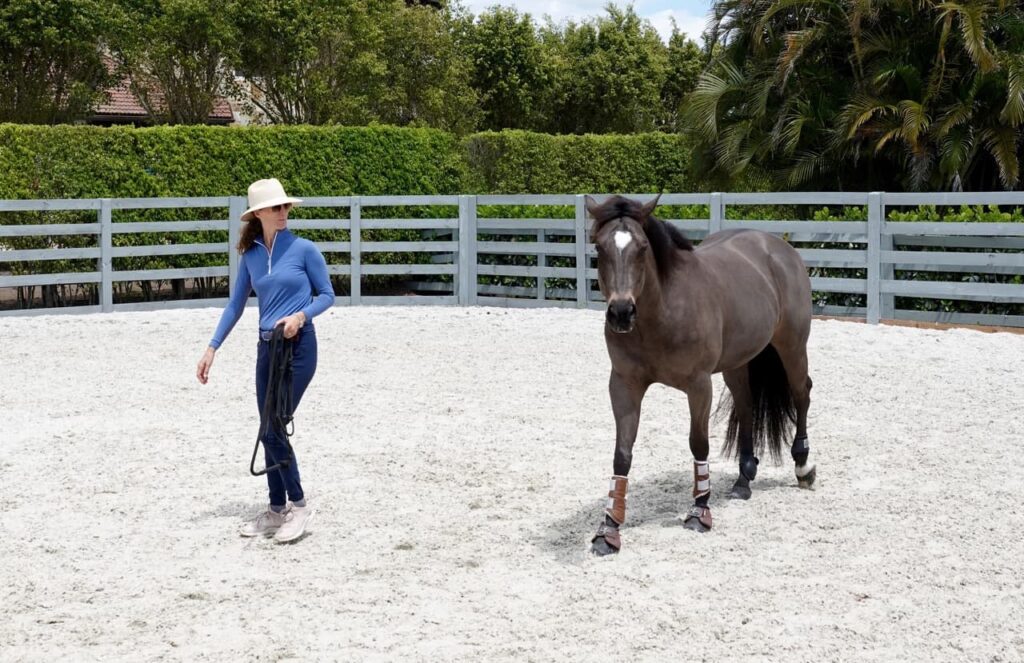
Again, he attaches, and we both enjoy the connection:
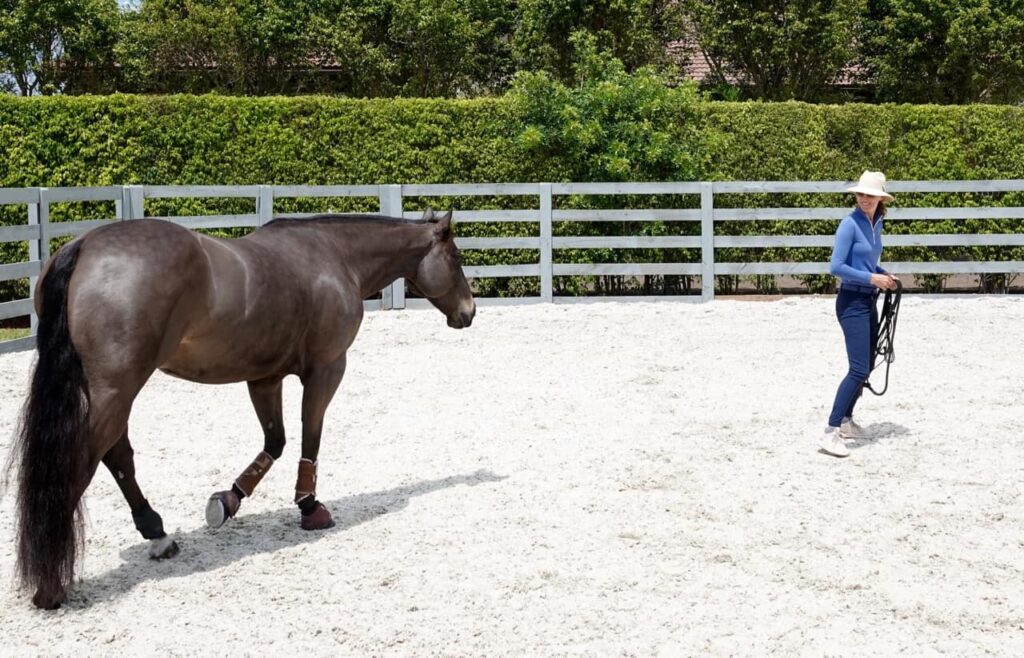
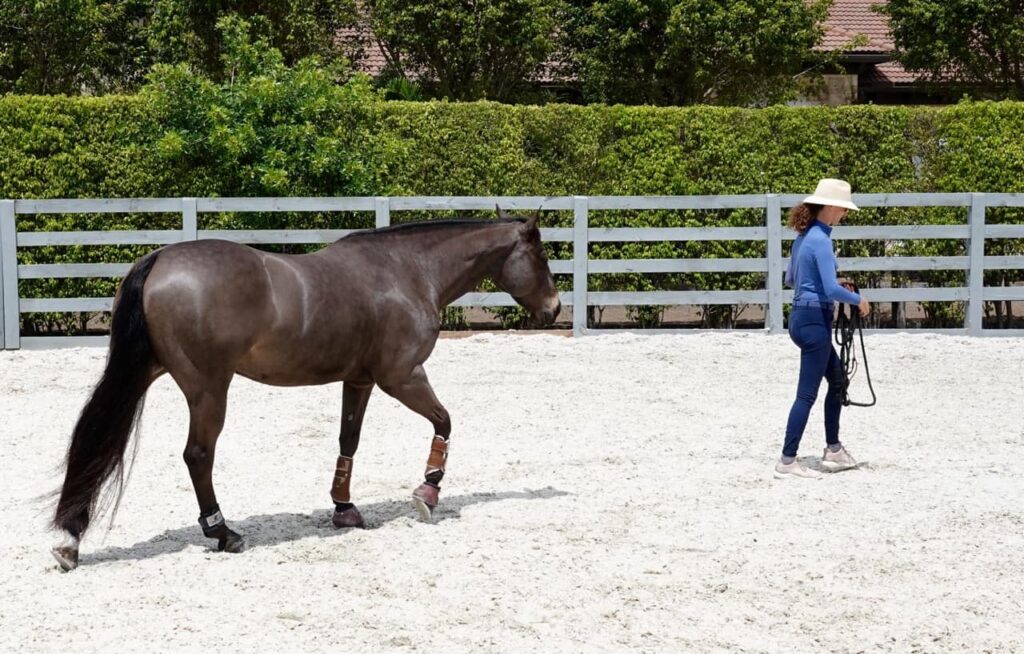
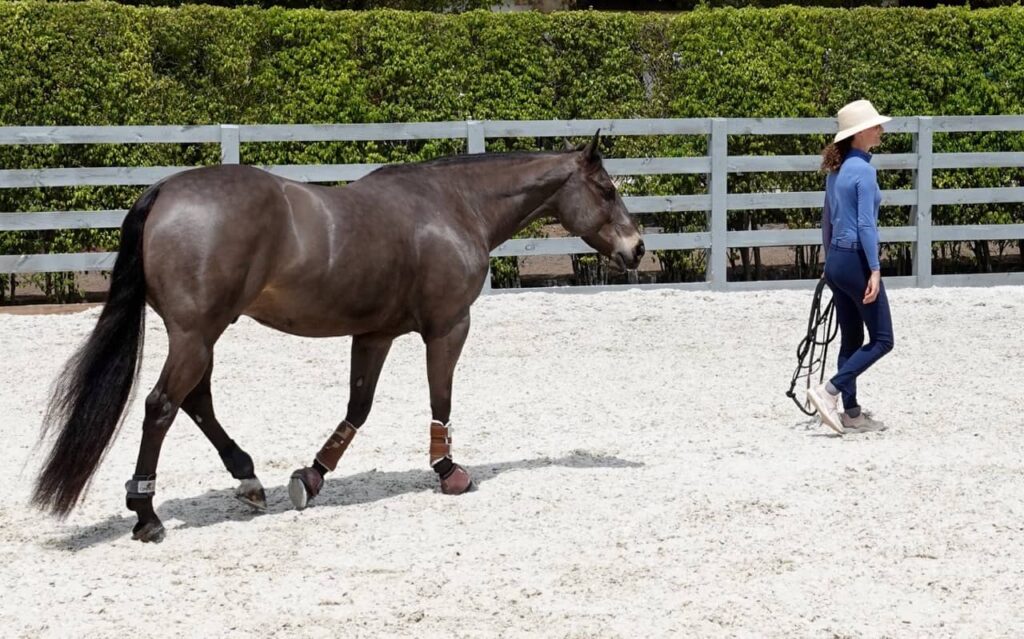
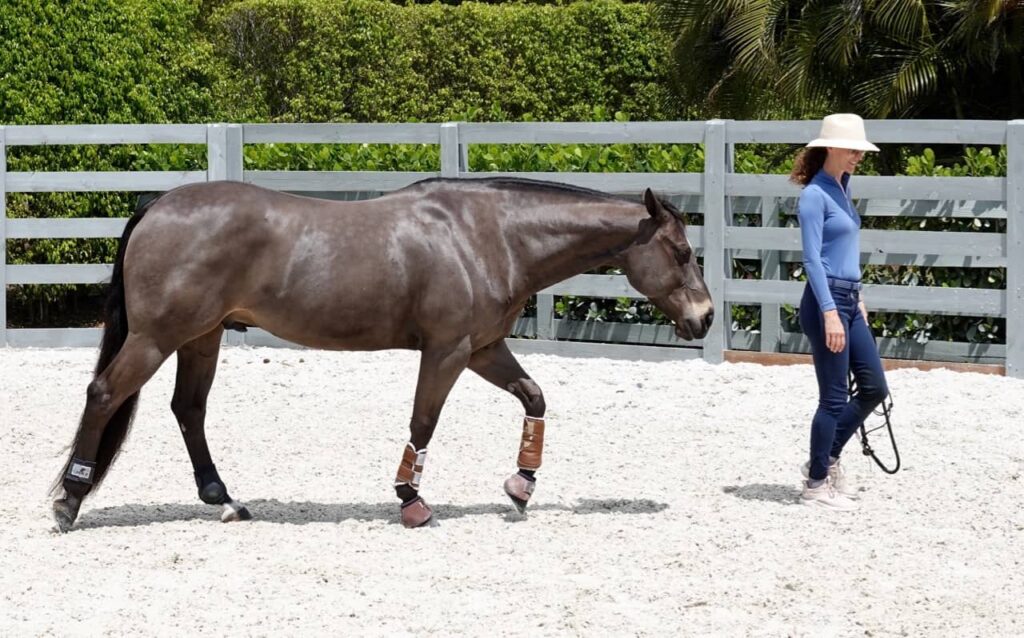
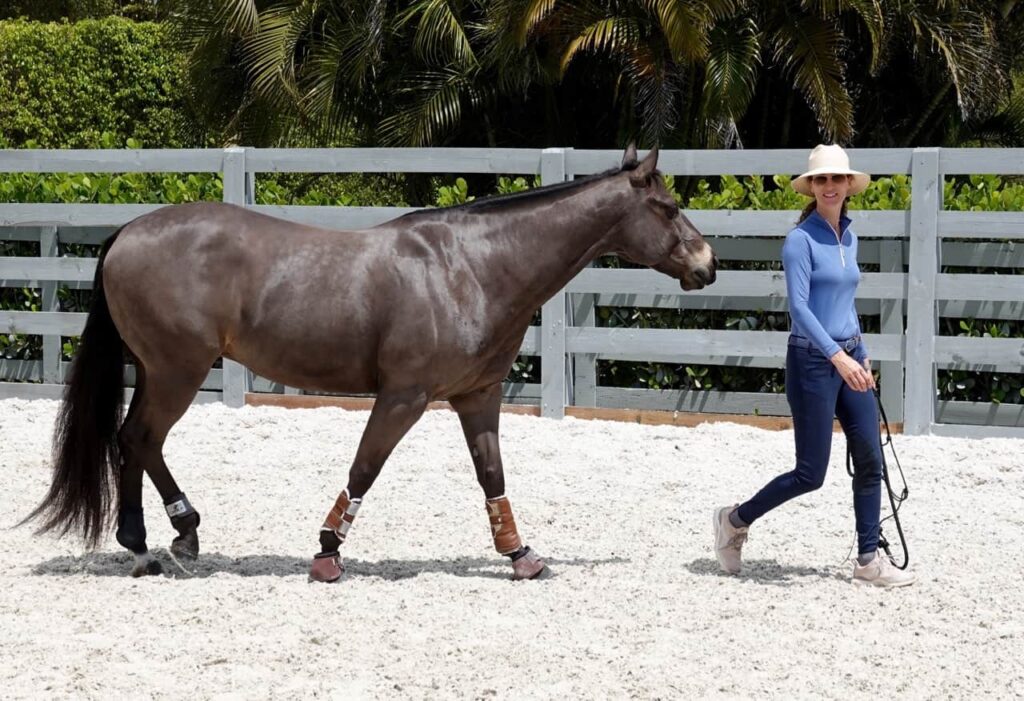
We finish by standing quietly together again. Even when he looks across the round pen, we’re still connected. He’s relaxed, not alarmed by whatever he sees, and he easily brings his attention back to me (notice the tilt of his ear in the second photo):
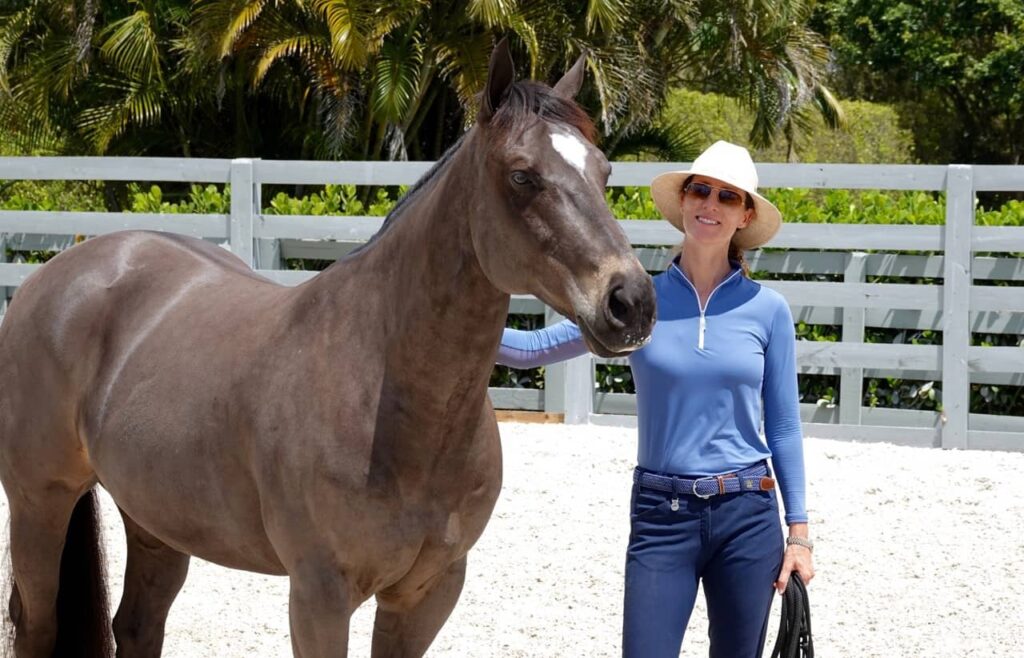
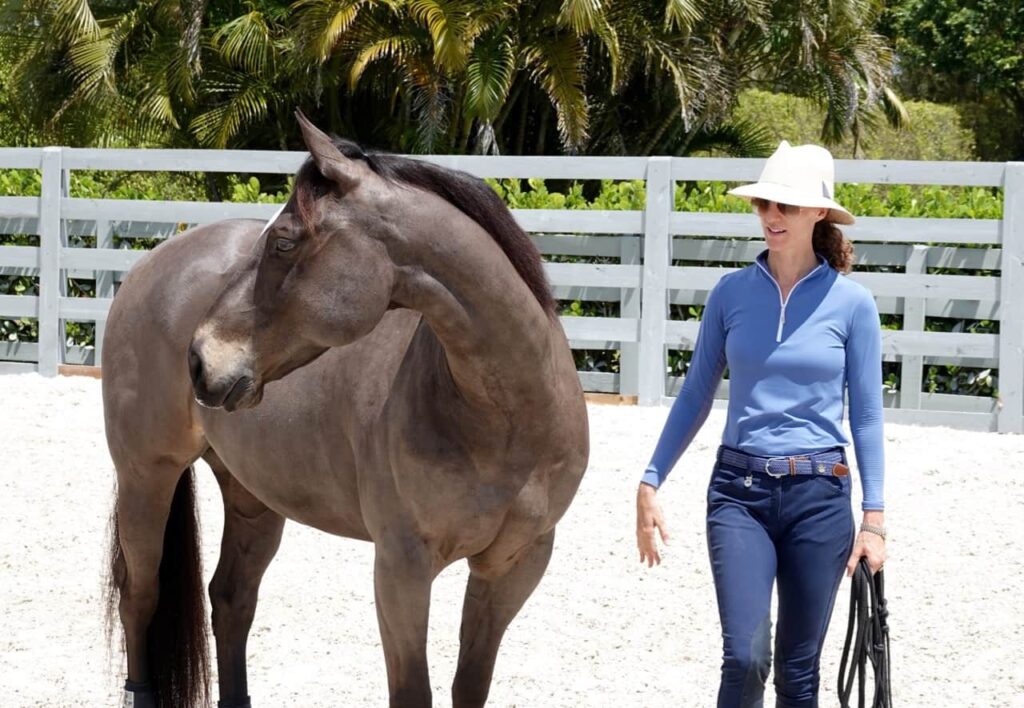
Photo series by my husband, Philip Richter
Horsemanship Insights
The legendary horseman Bill Steinkraus wrote, “Since the horse will have the last word in any case, we must try to ensure, through skill, tact, and moderation, that this last word is ‘yes.’”
Natural Lifemanship explains what that “skill, tact and moderation” consists of in its most evolved form: it’s about understanding the horse’s mind, including the neurobiology, in order to form a true partnership.
The very best compassionate horsemen might talk about leadership and submission (both Steinkraus and Sarah Dawson sometimes do, eg.) But in practice, the way they relate to their horses aligns closely with Natural Lifemanship principles. The best horsemen do create partnerships of mutual respect and trust. For them, this framework can provide some new language, a subtle shift in thinking, and a brain-based explanation for why their methods work. Plus maybe a few new tools and techniques, in the round pen and elsewhere.
In other cases, horse trainers could benefit from a major paradigm shift that encompasses not only their ideas but also their actions.
The Main Ideas
Submission should not be the goal. We do need to stop the horse from misbehaving because it’s not good for the relationship. But we don’t want the horse to be stuck in his lower, survival-based brain. We don’t want to dominate or control him; we want him to learn to appropriately control himself.
The most effective trainer neither coerces nor placates the horse. Instead, she uses well-timed pressure and release to have a conversation, with a goal of mutual understanding, trust, and connection. To succeed at this, she must be able to regulate her own internal state, in order to help the horse learn to regulate his. She does what’s right for the relationship, and the horse learns to do the same.
When horses learn to slow down, think, and freely choose to do the right thing, they become not only happier but better at their jobs, whether competing or trail-riding for pleasure.
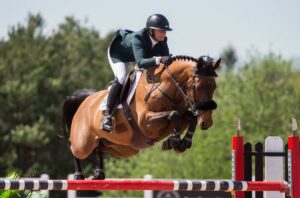
Connecting in Everyday Life
Although Natural Lifemanship arises from a framework of healing trauma, it can help everyone. We all benefit from enhanced self-awareness and self-regulation. We all benefit from relationship-building skills. Through this work, we can learn to stay calm and grounded when faced with challenge; to enjoy more fully those moments of connection with others, and to create the most fulfilling relationships possible with people and animals.
A Few Takeaways
Make connection the priority.
Whether talking with coworkers, walking your dog, or working out a disagreement with a family member, prioritize connection and you’ll get a much better outcome. Rather than fixating on issues, trying to control others, or insisting you’re right, try to connect. This approach leads to considerate listening and more genuine self-expression—which make for better immediate experiences and healthier relationships.
Plus, connection feels good; it cultivates wellbeing for yourself and those around you. As you go about your day, remember you can connect with others even in casual interactions.
Do what’s right for the relationship.
Let this principle guide you in your relationships with people and animals. Do what’s right for the relationship, and ask the other to do the same. This means you’ll communicate what you need and be aware of the other’s needs. You’ll make your own requests and listen to theirs.
Be aware of how much pressure you’re using.
When you communicate with others, be aware of how strongly you’re coming across. Think about what constitutes pressure in a given situation, and be mindful of how you apply it. Use the least amount of pressure necessary to get a response. And make sure you learn how to take the pressure off when you need to! (To learn more about this, you can attend a Natural Lifemanship Training.)
Cultivate your self-regulation.
In order to make use of these ideas, you need to be able to regulate your own system. Like well-traveled paths in the woods, the brain pathways we repeatedly use become our go-to reactions, while the ones we don’t use wither away. Notice your habitual thoughts and reactions. Learn to pause. You might make some subtle shifts that have a profound effect on how you feel and how you relate to others. A daily meditation practice can help.
Natural Lifemanship is both a science and an art. It helps us heal and evolve so that we can, in turn, have a positive impact on those around us. And the bottom line is, it just feels better when we live by these principles.
See more, and meet the horse-celebrity Grappa, at GrappaLane.com.
Find Natural Lifemanship trainings in your area.

by Laura McFarland | Jan 31, 2018 | Applied Principles, Basics of Natural Lifemanship, Equine Assisted Trainings, Personal Growth
When we sense God is with us, our relationship with God develops through the experience of ‘connection through attachment’, which is a perceived sense of nearness. At other times, perhaps times of great loss or suffering, we may sense God is nowhere to be found. A joyful sense of connection seems to dissolve into a deep well of emptiness with no consolation. We may then experience what 16th-century mystic, John of the Cross, described as the “dark night of the soul.” In actuality, just as winter makes way for spring, this period of perceived absence and isolation potentially gives birth to an even greater spiritual resilience – an abiding sense of connection that survives even our darkest nights. We are invited into a deeper and more mature intimacy with God through the experience of detachment.
Both science and religion point to the fundamental forces and patterns of the universe as being essentially intimate and relational. While the language and the narrative may differ, the theme is the same. We exist in an utterly relational universe. Creation is ongoing as a dance without end. We, ourselves, are created over and over again as our bodily cells grow, mature, and die off, but not before giving life to countless new cells with new variations made possible through the myriad relationships and interactions that occur within our physical bodies and between our bodies and our external environments. No doubt similar processes are at work in the realms less observable, such as in the inner workings of our minds and hearts. Acknowledging this, all major spiritual traditions teach paths of transformation. If our minds and hearts are patterned like everything else in the knowable universe, they are always in the process of changing and evolving. We seek spiritual paths and, increasingly, science-based paths, to take a more active role in our personal evolution involving the growth and transformation of our hearts and minds.
I have prioritized this interest in my life from a very young age. I have learned from different spiritual paths as well as from the science of depth psychology, and more recently, neuropsychology, to help me navigate the journey toward a more whole and healthy life, characterized by a more authentic and loving relationship with myself and with others.
When I encountered Natural Lifemanship several years ago, I immediately recognized the opportunity to practice in practical, embodied ways many of the same processes at work in my spiritual journey. I’ve often reflected on how the principle of pressure has worked in my life to help me to grow more connected with self, with others, and with God. I’ve noticed the ways I’ve experienced pressure, at first as a kind of gentle nudging in my heart toward some kind of change process not fully understood. On some level, I feel I am asked to trust and cooperate with a process, although I may have no idea where it is leading. At the early stages I can’t quite put words to what is being asked of me or know how to respond, but the sense of pressure persists, gently increasing until I can’t ignore it anymore. At this point I start actively seeking an answer, which is Natural Lifemanship’s definition of resistance – not an undesirable thing, rather a positive search for an answer in response to pressure. In fact, my life’s most important lessons and periods of growth came about through the process of acknowledging some internally felt pressure, struggling with it, and finally cooperating, allowing it to change me in ways I never could have foreseen and never would have experienced without my willingness to trust, listen and observe, and cooperate, often blindly, with what I sense is being asked of me.
Another way NL has given concrete language to a pattern I’ve experienced in my deeply personal relationship with God is through the notion that the relationship grows through both attachment and detachment. Attachment in our spiritual lives refers to those wonderful life episodes and experiences where we acutely sense the presence of God, or a higher power, or a deeply felt connection with something greater, in our lives. This is usually felt as a consoling, meaningful, hopeful, warm and embracing presence utterly nurturing and sustaining us. It gives us the sense that all is well and that we can endure whatever struggles we may be experiencing.
The writers of the Judeo-Christian bible and many other religious texts all describe this sort of relationship, where faith is built through such affirming experiences. The early stages of faith can be described as a connection being built through attachment, or what is felt as presence, or the responsiveness of the subject of faith. This is even spoken of in Buddhism, a spiritual path generally unconcerned with the question of an ontological God, but essentially concerned with one’s epistemological relationship with What Is, with reality. Reality is what it is but our lens or our way of seeing and perceiving reality may be clear or it may be clouded. In the case of Buddhism, the lens of perception is polished through practice, but human nature is such that humans won’t persist at practice without some sense of reward. So it is said even in some forms of Buddhism that faith grows at the early stages as the pattern of the universe, being inclined toward evolution, reinforces a sincere practitioner’s efforts in faith (causes) by producing tangible effects experienced as answers to prayers.
There comes a time, however, when faith is tested. There are periods of our lives for many of us in which we feel disconnected from the faith that has sustained us. We experience no sensation whatsoever of the presence of God. Our vivid, Technicolor faith lives seem to have become monochrome and dull. To the extent that we have felt a deep connection before, we may feel utterly abandoned. We may cry, as many of the psalmists and even as Jesus did, “my God, why have you left me?” John of the Cross poetically described this dimension of our spiritual lives as “the dark night of the soul.” As a spiritual director, he did not wish the dark night on anyone but listened for it in those he counseled. Not everyone will experience a dark night, for there are those who may never cease to find consolation when they seek it in their daily lives and normal activities of faith. John maintained that one shouldn’t give up these routines or activities so long as they are producing satisfying results. This is a blessing in and of itself.
Some, though, are invited into a deeper intimacy with God through a fundamental testing of our faith. John of the Cross describes it this way (paraphrased): Our hearts were made for intimacy with the One who created us, and nothing less than a connection directly with our Source will satisfy us at the deepest level of our soul. And yet in our lives, we easily become attached to the more surface consolations available to us and we may rest our identity in something less than our truest selves – which is our true nature as children of God. God, therefore, weans us off of our reliance on consolations – or felt presence – by seeming to withdraw from us. The dark night can, therefore, be understood in NL terms as God, or our relationship with the Divine (however we know the Divine), practicing connection with detachment with us.
The goal is that we begin to cultivate a secure attachment, or enduring sense of connection – one we readily turn to regardless of whether we perceive God as being with us, or not. In Christian theology, God enacted the same pattern by being with humanity (through Jesus’ human presence) to withdrawing from humanity (Jesus’ death) to presence again (appearances after the resurrection) to withdrawal (Pentecost) but at the same time gracing humanity with the presence of the Holy Spirit, also known as “the comforter” or consoler. This pattern of attachment and detachment to build secure attachment (connection) in relationship is written into the gospel, itself.
My hope for all who read this is that in those moments of despair or loneliness and isolation, you find peace knowing that your Source of comfort and of life itself may not always seem near but it is always within. Know that perhaps you are being invited to discover and to rediscover an even more enduring sense of connection in the depths of your lives, one that doesn’t rely on any evidence of response (such as answered prayers) or a felt sense of presence. May we all develop a deep connection with self and the indwelling Spirit that is attuned to the still small voice within. The reward of such a sense of connection is the relationship itself – a “secure attachment” both earned and given by grace.
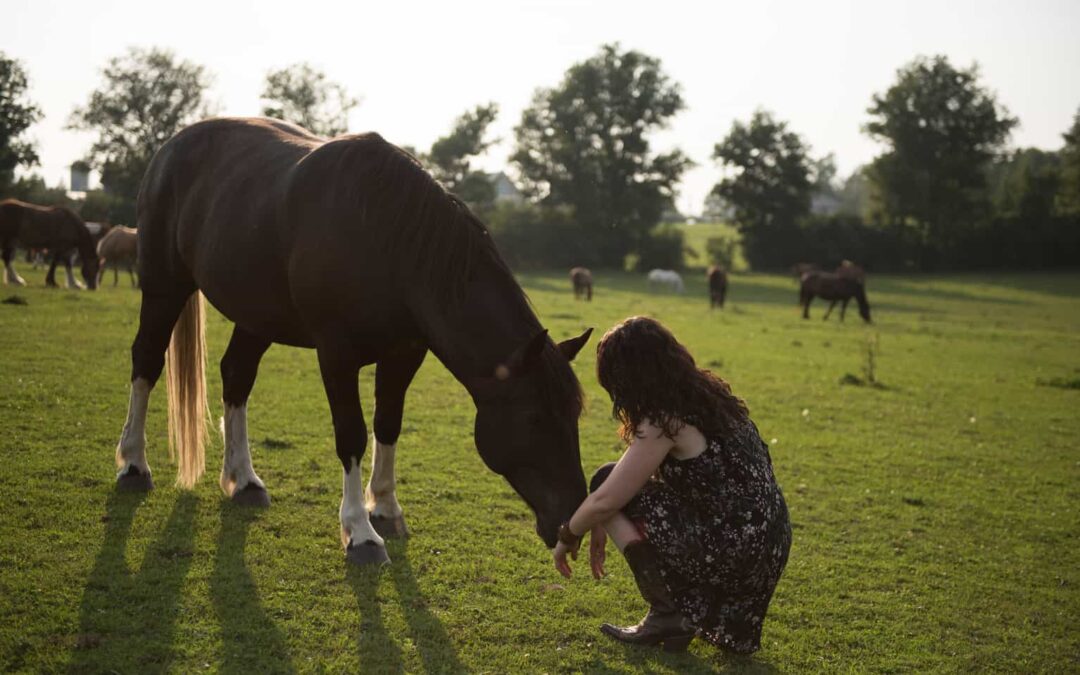
by Sarah Schlote | Jan 4, 2018 | Horsemanship, The Latest in Equine Assisted Therapy and Learning
July 1, 2021: It has come to our attention that this blog post is being misused on Twitter to justify animal abuse.
******************************************
Can Animals Consent? By Sarah Schlote
This interesting question, which came out of a post I shared on Facebook (here and here) about a yoga on horseback video that went viral recently, elicits differing opinions. Some claim that consent is a human construct linked to morality, and therefore cannot apply to animals philosophically or legally (calling it anthropomorphism). Others claim that since all mammals share a similar neurobiology, responses to safety, danger and life threat, experience emotions, are sentient and perceptive — and that since both human and non-human animals can express “yes” and “no”, aversion, attraction, fight, flee, freeze, fawn, collapse, submit, and make informed choices — they can indeed “consent” or not (in their own way). This second group suggests that to deny animals the ability to consent is anthropocentric and can be a way to justify the exploitation of non-human animals for the benefit of people.
This article certainly will not resolve this debate, and its goal is not to malign or shame any particular horsemanship discipline, method, or equine-assisted intervention approach. Rather, I hope to invite curiosity and offer a different lens in a spirit of gentle openness and non-judgment about ideas that, while controversial, are nonetheless important to reflect upon.
The word consent means to permit or allow. Barbara Rector, one of the pioneers in the field of equine-assisted practice, understood the notion of consent in relationship with horses. Her exercise, Con Su Permiso, which means “with your permission” in Spanish, speaks to the idea that animals can communicate consent or permission through their body language and that healthy relationships are built on a foundation of mutual respect. Words are not the only way to express when something is a “no” or a “yes”, and Barbara is not the only person championing the idea that horses (and, indeed, mammals in general) can express permission or objection through their body language, of course. But, even so, this idea is not consistently applied in the field of animal or equine-assisted interventions.
A common statement heard in the industry is that the horses are always free to move away if they ultimately do not want to take part in something. However, what is the interpretation if they do not move away? Is it always because they are choosing to stay willingly and without coercion? One might not move away but show other signs of “not wanting to be involved” that are often missed or dismissed. Does that mean that someone (human or animal) who goes into submission, freeze, or collapse in the face of something they don’t want to do or experience is consenting? Shutting down technically is “allowing” something to happen on some level, but only because the other options (fighting back, fleeing) might not be possible or might lead to greater harm, punishment, pain or death. Equating “going along with” to “consent” is a very murky and dangerous proposition. There’s a distinction between being in the lower parts of one’s brain, dominated by survival physiology and reacting out of self-protection (instinctual), and being integrated and able to express conscious choice freely from one’s neocortex, when regulated and connected to self and other. And even this is not a clean dichotomy, but more of a continuum. Regardless, can consent happen when someone – human or animal – is hijacked by fear, terror, or primal subcortical self-protective responses in the face of coercion, control, threat, or helplessness? Can healthy relationships exist under those conditions? And how can there be connection in relationship without consent? Even the polyvagal theory proposed by neuroscientist Stephen Porges proposes that the capacity for social engagement and connected relationships decreases the more the nervous system is activated in sympathetic charge or in a dorsal shutdown.
Evolutionary biologist Marc Bekoff states, “over the years, I’ve noticed a curious phenomenon. If a scientist says that an animal is happy, no one questions it, but if a scientist says that an animal is unhappy, then charges of anthropomorphism are immediately raised. This ‘anthropomorphic double-talk’ seems mostly aimed at letting humans feel better about themselves” (2009). This phenomenon also occurs when people use “human” concepts like “addictions” and “neglect” when referring to other mammals, instead of sterile words like “stable vices” and “deprivation” which minimize and deny that non-human animals also sense and cope with pain and distress in ways that are remarkably like our own. The same also happens when discussing other animal emotions, in spite of the evidence from the field of affective neuroscience, or even when wanting to use the word “trauma” in relation to non-human animals, a leap many are still reluctant to make. The same can be said for extending the idea of consent to non-human animals as well. This does not mean that there are no differences between humans and non-human mammals, for indeed there are. But all too often a false dichotomy between us and them is created that seems to promote the status quo, rather than face the cognitive dissonance or discomfort that comes when recognizing the impact of one’s actions on others.
The following quote aligns particularly well with this trauma-informed perspective:
“Like many vulnerable humans, animals are capable, though often deprived, of making informed decisions about their lives. Animals can express assent and dissent, but we rarely respect their personal sovereignty in ways that acknowledge their aptitude for making choices. Play and cooperation among animals are examples of how animals can express consent with one another, but we don’t speak the languages of other animals, and they typically don’t speak ours. Even when they express dissent to us, their feelings are often ignored. The ways animals are exploited in research, entertainment, food and clothing production, and other areas of human society clearly defy their sovereignty – much like human exploitation does, suggesting that something much deeper is at work here. In addition to the physical violence animals suffer through, they also suffer from fear, anxiety, and depression – like we do – when their personal sovereignty is violated.” –Hope Ferdowsian, MD, MPH
If saying the word “consent” is still too politically laden, too controversial or too far of a mental leap to make, then using “assent and dissent” still conveys the underlying point. Anecdotally and the research shows that mammals – including humans and equines – are capable of choice and expressing their preferences and opinions. This does not mean that learning to tolerate things that are uncomfortable or doing things we or other animals don’t want to do does not have value. There is a need to be able to do so in life, to compromise, to do what needs to get done (even if unpleasant), such as having to do certain tasks or jobs to pay the bills, following through on commitments or requirements (work ethic), or using distraction in order to cope with an uncomfortable or painful medical procedure, for instance. But there is a far cry between getting a horse to comply with a medical practice that might benefit its own health and wellbeing in the long run, and getting a horse or other animal to comply or submit to an activity that seeks to provide some benefit to someone else at its own expense (or, at worst, causes harm to the animal).
While this issue is difficult to resolve at a macro level (such as using animals in medical testing or other industries that benefit humans – a conversation that is beyond the scope of this article), it is much easier to tackle at a micro level, such as in the field of equine-assisted practice, where partnership with a horse should be the foundation for growth and healing. If the healing, growth or enlightenment of one member of a relationship comes at the expense of another whose “no” is not being respected, what message is this conveying? How “healing” is an interaction if the needs of only one are being acknowledged or respected in the process? Doing so comes at the risk of reinforcing an unfortunate win-lose re-enactment that, ultimately, benefits neither and, at worst, is retraumatizing… something that may be all too familiar for either the horse or the human. Peter Levine, founder of Somatic Experiencing® (SE™), uses the term “renegotiation to refer to the reworking of a traumatic experience in contrast to the reliving of it” (In An Unspoken Voice, 2010, p.23). Reliving, or re-enacting, is repeating a familiar situation or dynamic without resolution. Renegotiating is experiencing a different outcome or experiencing oneself differently in a familiar situation, completing what did not get a chance to biologically complete (such as a self-protective response – the traditional definition of renegotiation within SE™) or repairing or restoring what was ruptured, such as relational trust and attunement. For instance, if one of the goals is for humans to connect with animals in a deeper way, how is this possible if the animal’s needs are disregarded in the process and they are tuned out, shut down, frustrated or merely tolerating the interaction? If one of the goals for humans is congruence, assertiveness and greater agency around voicing needs and boundaries, what is being modeled if the equines’ voice and boundaries are disregarded in the process?
It is important to acknowledge and balance the needs of both members of a relationship – even an inter-species one – especially when the relationship is purported to be the vehicle for healing. And, again, compromise and doing things we might not want to do from time to time are also necessary. But there is a difference between getting there through dominance, fear, submission, coercion, and shutdown, and getting there through mutual respect, choice, compromise, responsiveness to signs of “yes” and “no”, and connection. Offering animals choice does not inherently mean that humans have to relinquish theirs – or vice versa. Rather, it is about really hearing what is being communicated and negotiating from there in a way that honours both voices. Even if this is not always achievable for various valid reasons, aiming for win-win scenarios in human and inter-species relationships to the degree that is possible is nonetheless a worthwhile intention.
Even if equine-assisted practices are typically for human benefit, this does not mean that such programs cannot also seek to benefit the animals in some way. At the very minimum, the interaction will be neutral for the animals, and ideally both would gain from the interaction – the ethical concepts of “do no harm” and “do good” apply equally to the human client and the equines involved. The same can be said for the principles of trauma-informed care. Safety, choice, voice, empowerment, trust, collaboration, compassion – and, yes, even “consent” as defined in this article – can be applied to all those taking part, whether two or four legged, to the degree that is reasonably possible. Since these principles are foundational components of human therapy and of animal rehabilitation programs, extending them to equine-assisted practice also makes sense. After all, “a good principle is a good principle, regardless of where it is applied.”
*The word horse in this article was used to lighten the text. The points raised in this post can apply to other equines and mammals as well. Images in this article are by David Karaiskos Photography.
More information can be found at www.equusoma.com, www.healingrefuge.com, www.traumatrainings.com, www.traumainformedyoga.ca.
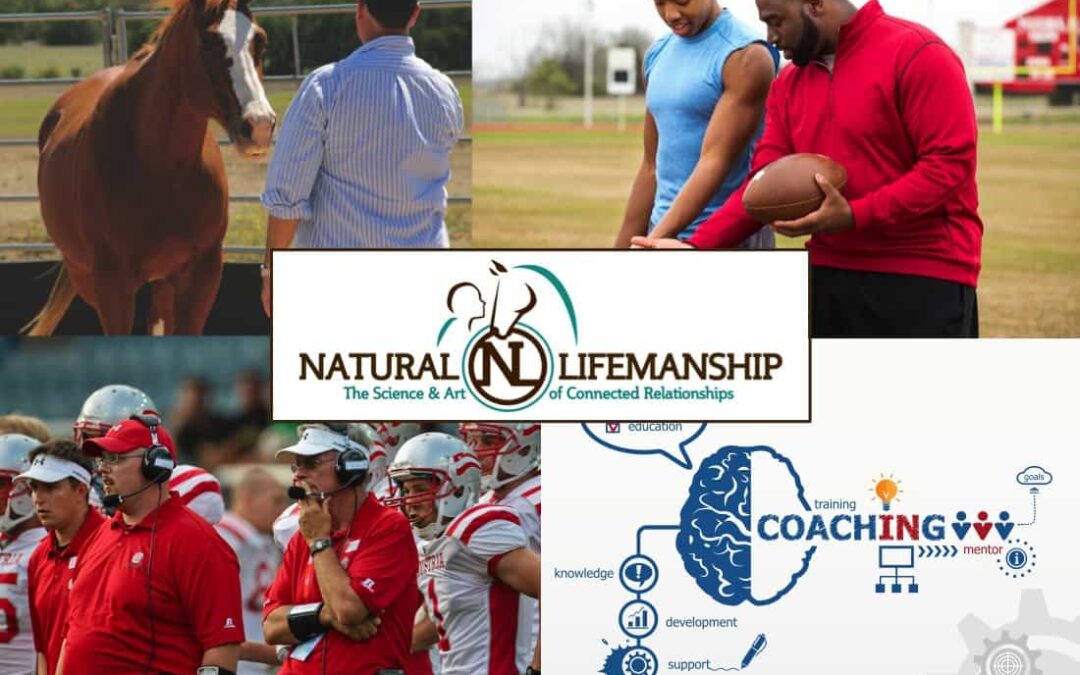
by Laura McFarland | Oct 6, 2017 | Applied Principles, Personal Growth
What does Natural Lifemanship (NL), a model that trains people in trauma-focused equine assisted psychotherapy and equine-assisted trauma informed care have to do with coaching, specifically in the sport of football? Great question.
According to my brother, a college Offensive Coordinator, NL offers coaches the skills, knowledge, and experiences needed to provide a much-desired competitive edge that will help teams perform at their highest potential. After watching my team, the Texas Longhorns (Hook ‘ Em!) make an impressive comeback this season in the first four games, yet still show opportunities for growth in very specific ways, I have to agree with my brother.
My observations in this blog are football-specific, but they actually speak to how NL is valuable to coaches in general. Different roles certainly bring different demands, which impact the specific nature of training for various sports or other professions. Nevertheless, there are certain constants that pertain to coaching.
One of these constants is that coaches want those they coach to perform and be their very best. Performing at the top of our game and living a life in which we fulfill our potential are intrinsically connected with our personal development – physically, intellectually, emotionally, and simply as human beings. Being our best and helping others to be their best means functioning optimally, and optimal functioning in all of life’s domains depends to a great degree on the optimal functioning of our bodies, brains and nervous systems. Understanding how the body, brain, and nervous system work together benefits those striving for their personal best and especially those who coach.
Another constant in coaching is that it is relational. The relationship between coaches and those they coach is understood to be instrumental in achieving the desired outcome of players performing or individuals living up to their highest potential. If this were not the implicit assumption then coaches would be out of a job. Understanding how relationships contribute to (or impede) personal or professional growth and development is a central concern of coaching. Being highly knowledgeable or highly skilled oneself does not necessarily make one effective at coaching others. A good coach has to have the ability to connect with his or her players. A great coach is a master in the art of relationship.
Whether one is a football coach, a tennis coach, a life coach, an instructional coach, or an executive coach, many of the same principles apply.
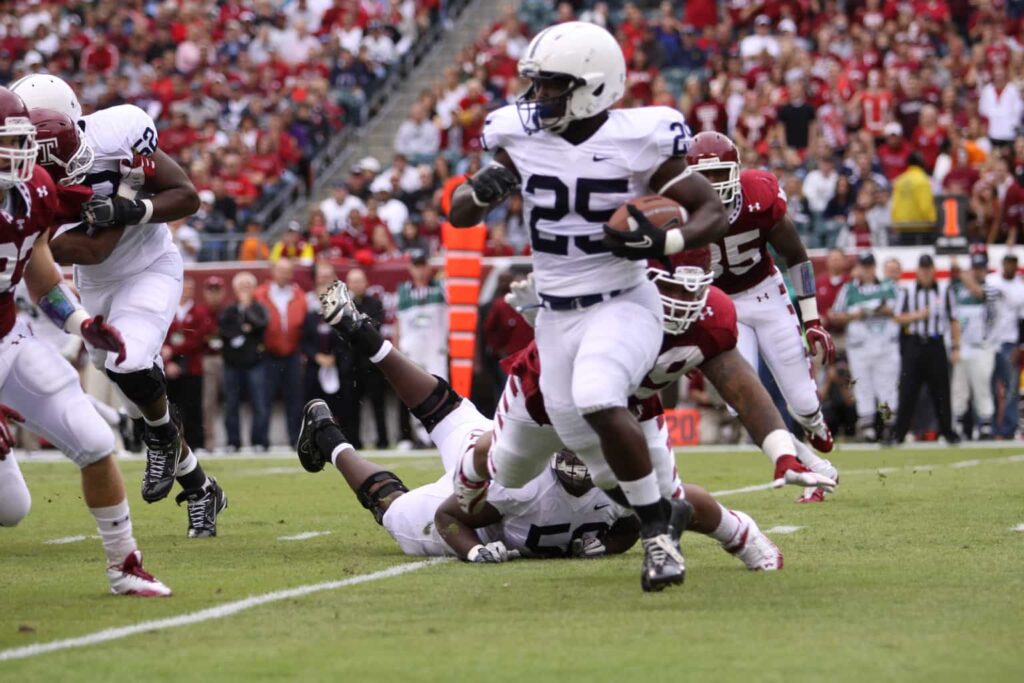
The top four reasons football coaches may wish to hone their skills through Natural Lifemanship during the off season:
1. NL gives coaches specific tools for building connected relationships while challenging players to grow.
NL teaches coaches how to push players in a way that creates stronger relationships between coaches and players and amongst the team. Nobody argues that good coaching is relational at its core. If coaches don’t earn the trust and the respect of players and aren’t able to build cohesion within their team, all the drills and training in the world won’t prepare the team to execute winning performance on the field. The challenge for coaches is to build these relationships through interactions that are necessarily going to bring out the resistance in players.
Resistance is natural and necessary for growth.
We define resistance as searching for the right answer, and any close relationship and certainly any growth-oriented relationship will eventually bring out resistance in people. If coaches never encounter resistance amongst their players, they are arguably not pushing them beyond their physical and mental limits and thus not promoting growth. On the other hand, if they push them too hard or too fast and without having built a connected relationship, the result is players may comply but only from the lower (“survival”) regions of their brains, which compromises the level of development needed for truly optimal athletic performance. NL gives coaches a neurodevelopmentally sound, principle-based set of knowledge and skills to cultivate relationships with players that result in players’ full, willing cooperation with the expectations of the relationship and not just automatic, subconscious compliance or obedience that eventually interferes with optimal performance and with connected relationship.
2. NL gives coaches a practical understanding of the brain – specifically what is required of a player, neurologically speaking – and how to prepare players to perform at their highest level.
Clearly a good football player has to be athletic and physically well trained but they also have to be present and have their entire brain engaged during a match. They need well developed and integrated pathways between the brain’s lower, automatic reactive regions responsible for survival and its upper, thinking, planning, and strategizing regions, as well as the mid brain regions responsible for relationship and connection with others.
Think of what is required of players. Good players must:
1. quickly and agilely react and move on the field
2. while exercising an acute awareness of space and perception of fast moving and often unpredictable stimuli on multiple collision paths
3. while making split second decisions
4. while experiencing a heightened sense of threat and often physical pain
5. while staying connected and aware of one’s team – moving and reacting in a coordinated way with one’s teammates
6. while maintaining a high level or strategic awareness of the match as a whole (the score, how many time outs are left, how much time is on the clock, what half and quarter and down it is, what are the strengths and weaknesses on the other team, etc.) so that split second decisions are not simply reactive but are also strategic in nature
7. and, they must be able to produce an intensely high level of explosive body energy while staying mentally calm and connected in the present moment
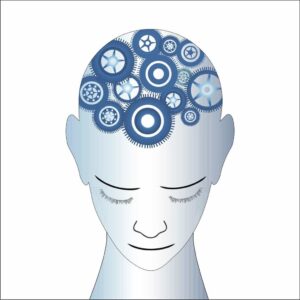
Football is thus very demanding when played at the highest levels. The list above specifies several discrete competencies that are involved when the ball is in play. At any moment multiple regions in the brain must be activated, functioning optimally, and communicating efficiently with other areas of the brain to execute quick, explosive action coordinated with calm planning and purpose.
By way of example, let’s say a team is ahead by one goal and there are only a few seconds left in the second quarter. The offense is in the lead. The wide receiver who catches the pass on the opponents’ 30 yard line starts running toward the goal. Naturally, his adrenaline is rushing and his single-minded impulse is to run as fast and far as he can to reach the goal, which seems deceptively near. However, given the circumstances, a better decision would be to run out of bounds giving his team the opportunity to score a field goal and gain a 10-point lead before the second half. The impulse to run toward the goal and the decision to run out of bounds are naturally exclusive of one another. They actually activate different neural networks in the brain. The ability to act according to strategic judgment that goes against one’s impulses is the hallmark of self-regulation, which requires integration or well developed pathways between the reactive lower regions of the brain and the thoughtful, problem-solving neocortical regions. Knowing this and observing this player’s behavior, a coach could determine that what would be helpful moving forward is helping the player reinforce self-regulation neural networks through specific exercises that have that effect.
NL gives coaches the tools they need to intentionally train players with the experiences needed to build and reinforce integrated networks in the brain that allow them to execute peak performance during a game.
3. NL gives coaches a trauma-informed lens that allows them to understand and work effectively with individual players who show up with histories that impact their abilities to perform and to relate in desired or optimal ways.
Trauma is understood today very differently than it was in the past. We now understand that multiple “little” or complex traumas – chaos, unpredictability, hurts, insults, neglects – especially relational ones – throughout childhood cause children to adapt in ways that alter their developmental trajectory over time. Behaviors that serve to protect people when they are faced with genuine threat are adaptive in the sense that they ensure our survival. As young adults on a football team or in a classroom or in the community at large (wherever a genuine threat is no longer present), these adaptive behaviors often become maladaptive. Maladaptive (i.e., situationally inappropriate and damaging) patterns of behavior get players into trouble and sometimes kicked off the field and off teams. Coaches are well served by having a trauma-informed lens, which comes from an understanding of neurobiology and how traumas (little or big) impact it. This will help coaches understand and work with players who are easily triggered, reactive, impulsive or otherwise impeded by behaviors that don’t serve them or their team well. Coaches can use the principles of NL to help players overcome those patterns through new relational experiences. Coaches must be equipped to respond effectively to players when they behave in ways that damage their relationships with others or with themselves.
4. Coaches need practice, too. Coaching is an art as much as it is a science. Because it involves relationship and relationships are dynamic and highly individual in nature, good coaching is not something that can be learned and developed at the intellectual level alone. By employing horses in our trainings for coaches, coaches have the opportunity to practice embodying what they learn through interacting mindfully with a horse. Horses are known for giving honest feedback because they don’t respond to our words or even our outer actions. They respond to what they sense from our body energy, something we are often unaware of ourselves. In the same way, good coaching requires a coach be mindful and attuned to their players. NL provides a powerful training experience to cultivate knowledge, mindfulness, and attunement that give coaches the edge they need to be more effective with those they coach.
For more information on NLR – our line of trainings and certifications for coaches – Contact Us




































Recent Comments